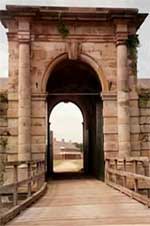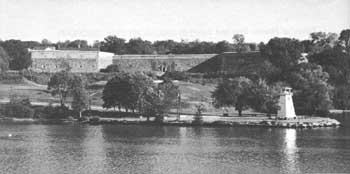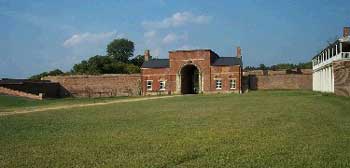





Survey of Historic Sites and Buildings
 |
FORT WASHINGTON PARK Maryland |
 Fort Washington Park |
| ||
This fort, constructed during the period 1814-24, is an outstanding example of a 19th-century coastal defense. The first erected to defend the Nation's Capital City, it was designed to withstand attack by wooden naval vessels, armed with smooth-bore artillery. Its high masonry walls, gun positions, dry moat, and drawbridge illustrate some of the then prevailing principles of military science and architecture.
Despite the construction of the Capitol at Washington and the relocation there late in 1800 of the Government from Philadelphia, almost a decade passed before Congress took any steps to provide for the defense of the city. Congressional reluctance to do so was not dispelled until Europe's Napoleonic Wars came dangerously near U.S. shores. In 1808, after the repeated seizures of U.S. seamen and the detention and search of the U.S. Frigate Chesapeake by a British warship, Congress appropriated funds for harbor and port defense.
 |
| Just after the War of 1812, the U.S. Government constructed Fort Washington, Maryland, to guard the Capital City from attack. Although never attacked, the fort remained active through World War II. |
George Washington originally selected the site of Fort Washington, where Fort Warburton, completed in 1809, had at first been situated. In 1814, however, during the War of 1812, the commander destroyed and abandoned it without resisting a British naval and military force en route to join that which had attacked Washington. Wartime anxiety for the safety of the Capital induced Acting Secretary of War James Monroe to engage the French engineer Maj. Pierre Charles L'Enfant to reconstruct the fort. L'Enfant had more or less free rein. In 1815, by which time the British threat had subsided, Monroe, concerned over expense, replaced L'Enfant with the economy-minded Lt. Col. Walker K. Armistead. Fort Washington was completed in 1824 at a cost of $426,000.
Extensive modifications during the 1840's, still visible today, included construction of 88 permanent gun platforms for barbette carriages, erection of a new drawbridge, the addition of a bastioned outerwork to strengthen the south wall, and improvement of the powder magazines. Early in the Civil War the Secretary of the Navy assigned 40 marines to the fort, the only fortification defending Washington. As a naval attack became less probable, its importance declined, particularly after the completion of Fort Foote, opposite Alexandria, in 1864. In 1872 the Government abandoned Fort Washington and 13 years later removed the obsolete muzzle-loading guns. During the period 1896-1921 it was headquarters for the Defenses of the Potomac. Eight concrete batteries, erected during this period, may still be seen. From 1921 until 1939, when transferred from the War Department to the Department of the Interior, the fort was headquarters of the 12th Infantry Division. Shortly after the Japanese attack on Pearl Harbor, it reverted to the War Department; later it was transferred to the Veterans Administration. Finally, in 1946, it was returned to the Department of the Interior for park purposes. Rehabilitation began in 1957 under the Mission 66 Program.
 |
| Fort Washington. |
The fort area is open to the public daily. A small museum interprets its history. The masonry fort has been little altered in basic form since 1824. It is entered by a drawbridge across a dry moat at the main gate. Approximately 60 feet below the fort is an outer V-shaped water battery. Two half-bastions overlook the river above and below the fort. Below the ramparts of these two structures are the casemates, or bombproof gun positions. Guns of the water battery, casemate positions, and ramparts could deliver a devastating fire against an enemy fleet on the Potomac from three different levels. On the parade ground are the officers' quarters and soldiers' barracks, near which are magazines. A guardroom, containing two narrow cells, and a museum are located in the main gateway structure.
 |
 |
http://www.cr.nps.gov/history/online_books/founders-frontiersmen/sitea13.htm
Last Updated: 29-Aug-2005